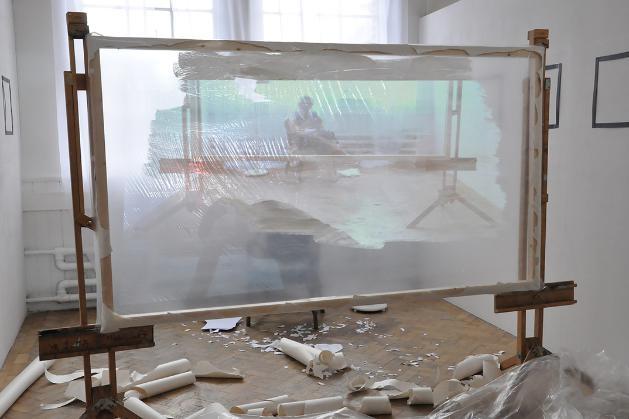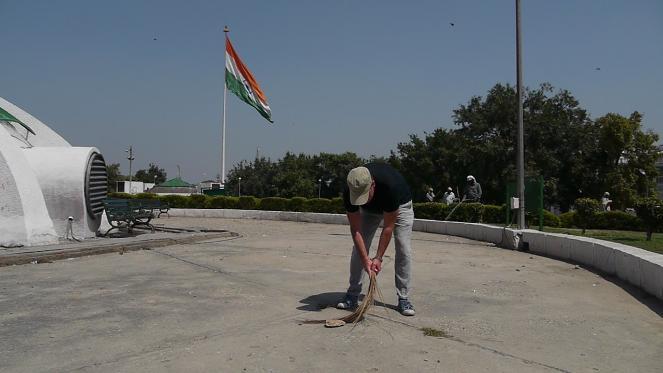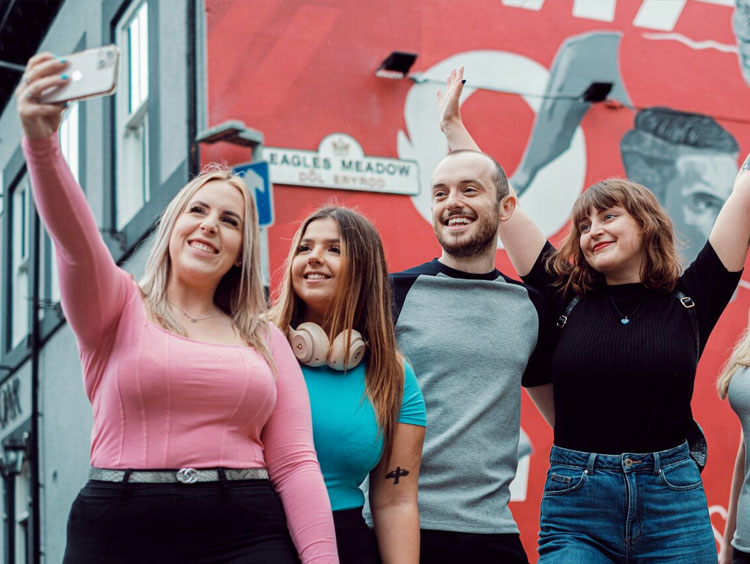.jpg)
Art & Design

Unit of Assessment D32:
Art & Design
REF2021 was Glyndwr’s debut for submitting to the Art & Design unit. Over 62% of research outputs were of a quality that is recognised internationally in originality, significance, and rigour, with 100% of impact case study content showcasing considerable or very considerable impacts in terms of their significance and reach.
Impact Case Study 1: Arts and Health Ecosystem in North Wales
What is it?
The Arts have been used for health applications across North Wales, resulting in a burgeoning Arts in Health ecosystem and a growing community of best practices.
Who was involved?
Art and Design staff and a PhD student from Glyndwr University worked with key stakeholders from across North Wales.
What was done?
Networking and collaborating with stakeholders led to a practice-based research project called ‘in-between-ness’, which applied the visual arts to treatment processes for those with clinical depression. This project was the foundation for ‘the potential of painting’, which similarly investigated painting as a means of expression and communication for those living with Dementia.
What was the impact?
The projects underpin the team’s contribution to policies and guidelines via steering committee membership of Wales Arts, Health, and Wellbeing Network, representing over 90 arts practitioners in Wales. The work was presented at The Senedd Cymru Cross Party Group on Arts and Health, The UK Parliament All-Party Parliamentary Group for Arts Health and Wellbeing (2014-2017), and The Welsh NHS Confederation, and the team also addressed the Welsh cabinet secretary for Health and Social Services at the launch of The North Wales Concordat for Arts and Health. This dissemination shaped the content of policies and guidelines applied within the health and social care sector, embedding arts in health initiatives across the Welsh NHS. The work also shaped training, development, and working practices for arts and health practitioners and showcased positive wellbeing impacts for service users.
References to Research
Visual Arts, Mental Health, and Technology
Time and the Chora: 'Transitory Strata' and 'in-between-ness' within 'Dream Films'
The Potential of Painting: Unlocking Disenfranchised Grief for People Living With Dementia
Impact Case Study 2: ‘Carbon meets Silicon’ Curatorial Projects & Collaboration
What is it?
Carbon meets Silicon was an exhibition focusing on marrying together people with science and encouraging interdisciplinary collaborations across the arts and beyond.
Who was involved?
Staff within Glyndwr Art and Design and Visiting Research Fellows were involved in the underpinning research and subsequent exhibitions.
What was done?
A new conceptual model, ‘Show-talk-do’ was developed from the exhibition series, which brought together international artists, scientists, and researchers worldwide, spawning a new international network and providing a novel model for use within interdisciplinary research processes.
What was the impact?
The research provided a new conceptual model to support curators and researchers internationally, and inspired new forms of artistic expression and innovation. The model allows researchers and curators to generate new ways of thinking, influencing creative practices. The collaborations with North Wales’ businesses contributed to their organisational resilience and opened up new funding streams leading to projects such as the EDGE for Schools from Arts Council Wales. Furthermore, the research engaged the general public in academic research processes and helped public visitors contribute to the quality of the tourist experience.
References to Research
Interdisciplinary Research Unmasked: a new curatorial model for multi-audience engagement
Outputs
Output 1 (Susan Liggett)
Type of output: Book Chapter
Title and Description: ‘Framing the Conversation: the role of the exhibition in overcoming interdisciplinary communication challenges’ is a contribution to ‘Technology, Design and the Arts - Opportunities and Challenges Part II Chp.3 edited by Rae Earnshaw, Susan Liggett, Peter Excell, Daniel Thalmann, Springer Publishers (July 2020)
_________________________________________________________________________
Output 2 (Susan. Liggett)
Output Type: Book Chapter
Title and Description: ‘Positioning the Arts in the Research Process’ is a contribution to: ’Technology, Design and the Arts - Opportunities and Challenges, Chapter 2, edited by Rae Earnshaw, Susan Liggett, Peter Excell, Daniel Thalmann, which is part of the Springer Series on Cultural Computing book series (SSCC) published (July 2020).
_________________________________________________________________________
Output 3 (Susan Liggett)
Output Type: Other – curatorial project
Title and Description: ‘Carbon Meets Silicon’: exhibition, conference and journal article
Additional information
This curatorial project is a multi-component submission underpinned by research in three parts; exhibitions (‘Carbon Meets Silicon’; CMSI&II 2015/17), conferences (Internet Technologies and Applications; ITA 2015/17) and a journal article (‘Interdisciplinary Research Unmasked: a new curatorial model for multi-audience engagement’).
_________________________________________________________________________
Output 4 (Alec Shepley)
Output type: Exhibition
Title and Description: ‘A Place of Impossibility’.
This multi-component submission is underpinned by research in two parts: an exhibition with publication/project proposal and journal article to disseminate and peer review the work.
Exhibition: INSERT2014 titled 'New Models on Common’, Delhi, 2014.
Journal Article ‘Camping in a Mudhouse: Ruins and Fragments as Tropes of Reflexivity’ (Shepley, A. 2016)
Additional Information
The underpinning practice as research comprises a speculative artwork entitled, ‘A Place of Impossibility’ developed for an imaginary urban development in Delhi as a contribution to a group exhibition (page 90 of exhibition catalogue). This work was among 25 submissions invited by Raqs Media Collective to exhibit full proposals in the exhibition curated as part of INSERT2014 titled, 'New Models on Common Ground’, Delhi 2014.
___________________________________________________________________________
Output 5 (Alec Shepley)
Output Type: Exhibition
Title and Description: ‘Ibid’ comprises of artworks, solo exhibition at Kuandu Museum of Fine Art, Taipei Museum of Fine Arts, Taipei and exhibition publication (2014/15).
Additional Information
This multi-component submission consists of artwork, exhibition, and publication to peer review the research project titled ‘Ibid’. ‘Ibid’ is a provisional site of accumulated debris, installed to engage the viewer’s experience of the artist’s making and unmaking. Through grouping together a range of highly selective media and materials, including text and video, found and made objects, sound and lighting, painting, photography, and stagecraft, ‘Ibid’ invites the viewer to walk the site, to get inside the work, and reflect on the possibility of new and meaningful representation(s).
Shepley was one of four artists selected from an international juried call for the ‘Power’ Arts Council of England funded exhibition at Kuandu Museum of Fine Art, Taipei where he staged ‘Ibid’ in 2014/5.
Exhibition at Kuandu Museum of Fine Art, Taipei Museum of Fine Arts, Taipei and exhibition publication (2014/15).
Artwork includes a filmed performance ‘I am from Leonia #5’ made as a document of an on-site, durational activity cleaning the abandoned seminary of St Peter's, Kilmahew, Scotland 2014 and exhibited as part of ‘Ibid’ in Taipei.
_________________________________________________________________________
Output 6 (Karen Heald)
Output type: Exhibition
Title and brief description: ‘In-between-ness’.
Additional Information
This multi-component submission is underpinned by research in three parts: artwork, exhibition/symposium, and book chapter to disseminate the work.
In-between-ness was a practice-based research programme collaborating with a clinical psychiatrist to explore changes in patients’ creative expressions prior to, during, and after treatment for depression, 2012/13.
Made in response to In-between-ness, ‘Paper Interior’ is a video performance selected to be performed and installed at ‘Slippage: The Unstable nature of difference’, an exhibition that challenged the boundaries of physical and psychological identities. The ‘In-between-ness’ research project was presented at the accompanying symposium on arts and disability.
Book chapter, ‘Visual Arts, Mental Health, and Technology’ contextualises the ‘In-between-ness’ project through articulating how adoption of new technologies by artists have contributed to cross disciplinary arts in health initiatives in the UK that address mental health.

_________________________________________________________________________
Output 7 (Stephen Kenyon-Owen)
Output Type: Journal Article
Title and Brief Description ‘Choking on the Splinters: Art, the Body, and Processes of Adaptation in the work of Tom de Freston'
Kenyon-Owen, S. C. (2020) ‘Choking on the Splinters: Art, the Body, and Processes of Adaptation in the work of Tom de Freston', in Stutesman, D. (ed), FRAMEWORK - The Journal of Cinema and Media, 60.2, Detroit: Wayne State University Press. pp. 151-174.




